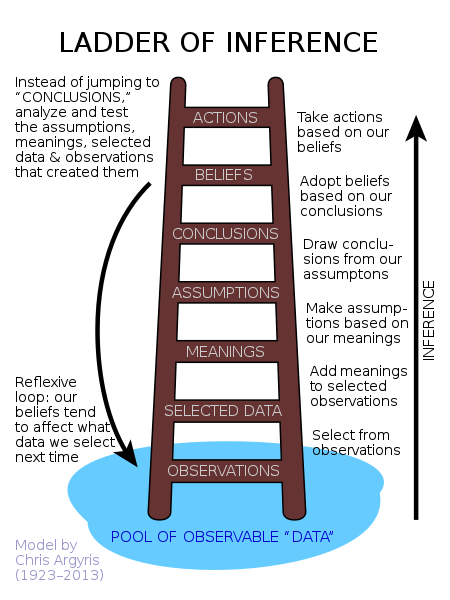Jumping to Conclusions? Climb a Ladder Instead!

Image: by fizkes from Getty's Images via Canva
I’m occasionally invited to events where start-ups pitch their ideas to a group of prospective early stage investors. I am amazed by how the same pitch triggers a different conclusion in different investors. While there are any number of reasons why investors may choose to invest or not invest in a venture, I felt there should be more agreement on the fundamentals - whether an idea is viable or not. After all, they are considering the same data.
Different people arrive at different conclusions based on the same information. Chris Argyris[1] explained this phenomenon using the Ladder of Inference, a model that describes how we start with objective data, and through a series of subjective inferences, arrive at a conclusion, and then act upon it.
While, in principle, we all start at the same point - observable data, the subjectivity at each step of the ladder can result in different people reaching widely differing conclusions and reacting differently.
How we reach conclusions

Image Source: Wikipedia - Ladder of Inference
The bottom of the Ladder of Inference rests on the seemingly solid ground of observable data. A useful metaphor to think about this is to consider this data as something an unbiased data recording device would capture - for example a video camera.
The next rung of the ladder, selected data is where subjectivity first creeps in. My limited capacity for focus, habitual filters, states of mind and body, all determine the data I select. This can also be a key point of divergence - two people could end up selecting different subsets of the data. As an example, when we research holiday destinations, often from the same sources, I am mostly drawn to information on facilities and activities at different locations, whereas my wife is primarily looking at proximity to sight seeing attractions.
The next step is where we add meaning and make sense of the data. This meaning can be shared within a culture, or one that is very personal to us. For me, a hoarding announcing a new movie is just that - information that I acknowledge or ignore. For a member of the cast, however, the same hoarding can carry significantly more meaning.
Then follows the level of assumptions. Data is seldom complete, and we invariably make assumptions to complete the picture. This is another step where significant divergence is seen. For example, my reaction to your advice or offer for help, would depend on my assumption of your intent.
Evaluation and judgment come naturally to us, and at this step, we draw conclusions. Again, while we pride ourselves on being very rational and logical, our conclusions are heavily influenced by our values, beliefs, biases and mental models, and all the preceding steps of the ladder of influence.
The conclusions we arrive at usually reinforce existing beliefs. This is not surprising, since beliefs consciously and otherwise influence our inferences at several of the lower rungs, including data selection - what we choose to focus on.
Finally, our actions and responses, including what we say, arise from our beliefs.
Thus, the ladder of inference explains, how we progress from observation to action in a sequence of steps that usually happen unconsciously and rapidly.
However, the value of the ladder of inference is not just in its descriptive ability. The ladder of inference can be used as a tool to enhance our understanding of how we arrived at a specific conclusion, to explain our thinking to others, and to help understand how others think.
Using the Ladder of Inference
The first step in using the Ladder of Inference is to acknowledge that our conclusions are inferences we have arrived at, and not indisputable facts.
To make our thinking transparent to others, it is best to start at the lowest rungs - observations and selected data. Observations, at the lowest level, tend to be objective and verifiable.
The level of Selected data, while less objective, also offers opportunities to challenge, expand, and agree on the data that is used in the analysis.
The subjectivity increases as we go up the ladder of inference, hence it is important to spend enough time at the bottom of the ladder, and move to the next rung only when everyone is aligned. Without that alignment, it is pointless to move up the ladder, as the divergence only compounds.
Reaching this alignment requires us to make our thinking transparent - stating both data and inference, and inviting others to present their data and logic.
It is useful to figure out and label the contributions each participant makes - data, assumption, belief or interpretation. When there is agreement on something being an assumption or belief, it is easier to ask whether it is reasonable, justified or validated. Similarly, inferences and evaluations can be tested for completeness and logic.
The ladder of inference can therefore be used as a tool to make explicit our reasoning, reduce misalignment, and promote shared understanding.
Applying the Ladder of Inference
As seen above, the Ladder of Inference significantly improves our ability to:
This makes the Ladder of Inference useful in a number of contexts:
The Ladder of Inference is a versatile tool, easy to understand, and simple to implement. It will be a useful addition to every knowledge worker’s toolkit.
What are some recent instances where you have applied the Ladder of Inference?
What are some recent or recurrent situations where this might be a useful tool to apply.
If you have a situation where you think this would be useful, but are not quite sure how to get started, please leave a comment below or send me an email, and I’ll do my best to answer your questions.
Further Reading
[1] Action Science: Concepts, Methods, and Skills for Research and Intervention. (Argyris, C. et al., 1985)
[2] Ladder of Influence. Wikipedia.
[3] The Ladder of Inference. The Systems Thinker
[4] Solving the Problem with Problem-Solving Meetings. Harvard Professional Development | Harvard DCE

Comments are closed.